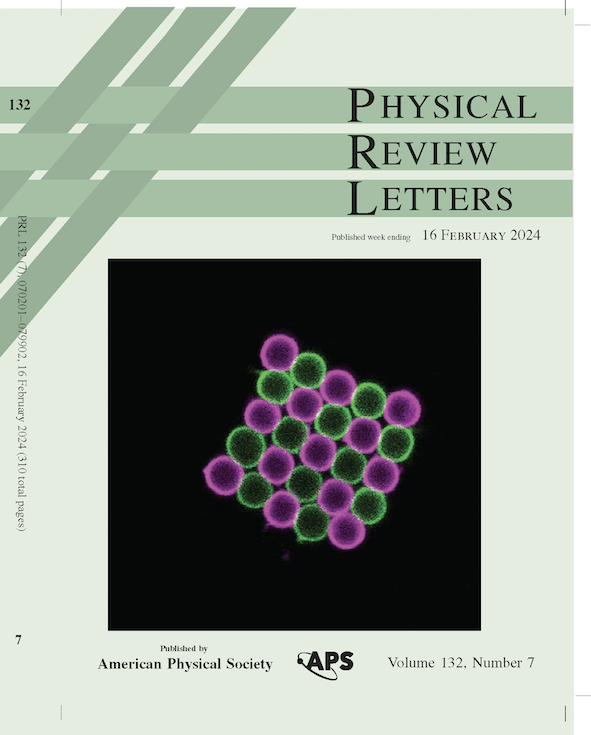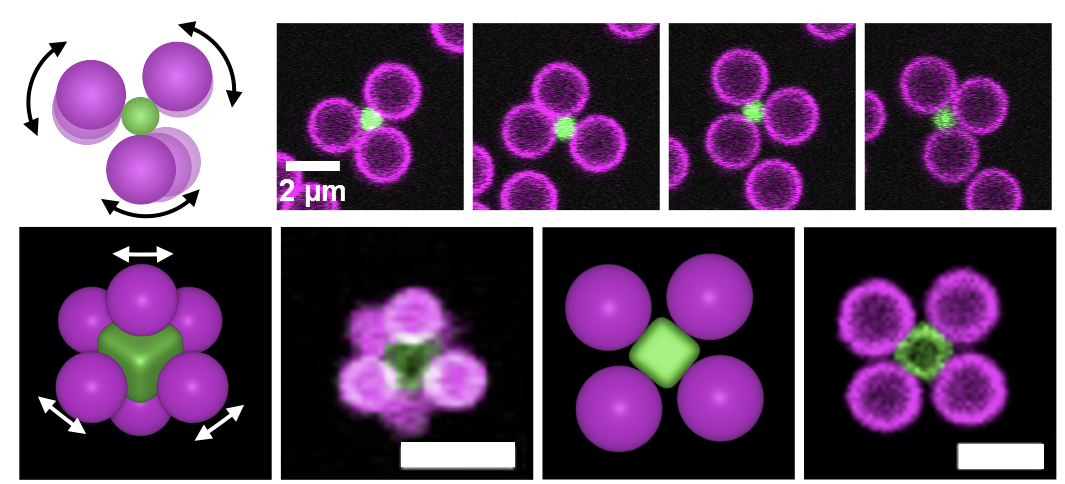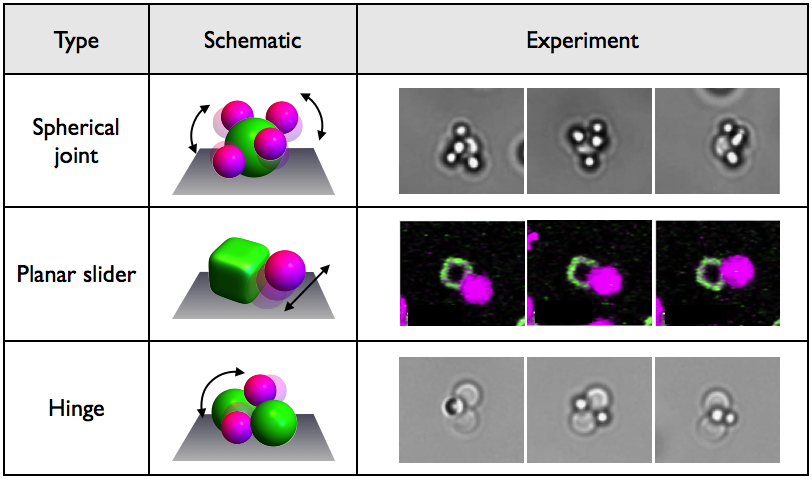Flexible colloidal structures
Soft and stiff modes in floppy colloidal square lattices

Floppy microscale spring networks are widely studied in theory and simulations, but no well-controlled experimental system currently exists. We designed square lattices consisting of colloid-supported lipid bilayers functionalized with DNA linkers and showed that they act as microscale floppy spring networks. We extracted their normal modes by inverting the particle displacement correlation matrix, showing the emergence of a spectrum of soft modes with low effective stiffness in addition to stiff modes that derive from linker interactions. Evaluation of the softest mode, a uniform shear mode, revealed that shear stiffness decreases with lattice size. Our experiments match well with Brownian particle simulations and in collaboration with Silke Henkes we developed a theoretical description based on mapping interactions onto linear response to describe the modes. Our results reveal the importance of entropic steric effects, and can be used for developing reconfigurable materials at the colloidal length scale.
Publication
- J. Melio, S. Henkes, D.J. Kraft, Soft and stiff normal modes in floppy colloidal square lattices, Physical Review Letters, 132, 07820 (2024)
Flexible colloidal molecules

Colloidal molecules are model systems for mimicking real molecules and can serve as versatile building blocks for the bottom-up self-assembly of flexible and smart materials. However, most colloidal molecules are rigid objects, and lack the conformational flexibility present in real molecules. We have realized flexible colloidal molecues, with a full and a restricted motion range. Even more so, the DNA-based bonds allow in-situ control over the motion range by a change in the temperature. The bond flexibility affects their self-assembly dynamics and enables high yields. Anisotropic particle shapes favor specific sizes of colloidal molecules and controlled flexibility originating from the multivalent bond.
Using optical tweezers, we can assemble colloidal joints in specific arrangements, such as chains and rings. The conformations and diffusion of these flexible colloidal structures can be studied by bright field and confocal microscopy. A comparison with theoretical models for linear and ring polymers revealed that our flexible colloidal structures are a powerful experimental model system for quantitative studies.
Publications
- R.W. Verweij, S. Ketzetzi, J. de Graaf, D.J. Kraft, Flexibility-induced effects in the Brownian motion of colloidal trimers, Physical Review Research, 2(3), 033136 (2020)
- R.W. Verweij, P.G. Moerman, L.P.P. Huijnen, N.E.G. Ligthart, I. Chakraborty, J. Groenewold, W.K. Kegel, A. van Blaaderen, D.J. Kraft, Conformations and diffusion of flexibly linked colloidal chains, Journal of Physics:Materials, 4(3), 035002 (2021)
- I. Chakraborty, D. Pearce, R. Verweij, S. Matysik, L. Giomi, D.J. Kraft, Self-assembly dynamics of reconfigurable colloidal molecules, ACS Nano, 16 (2), 2471-2480 (2022)
- R.W. Verweij, J. Melio, I. Chakraborty, D.J. Kraft, Brownian motion of flexibly linked colloidal rings, Physical Review E, 107/3, 034602 (2023)
- Y. Shelke, F. Camerin, S. Marin-Aguilar, R.W. Verweij, M. Dijkstra, D.J. Kraft, Flexible Colloidal Molecules with Directional Bonds and Controlled Flexibility, ACS Nano, 17 (13), 12234–12246 (2023)
Colloidal joints and hinges

The miniaturization of machines towards the micron and nanoscale requires the realization and integration of joint-like elements that enable and constrain motion. We developed such elements at the colloidal scale by levering colloidal particles functionalized with mobile DNA linkers. Using spheres, cubes, and dumbbells, we experimentally realize spherical joints, planar sliders, and hinges at the colloidal scale.
Publications
- I. Chakraborty, V. Meester, C. van der Wel, D.J. Kraft, Colloidal joints with designed motion range and tunable joint flexibility, Nanoscale, 9 (23), 7814-7821 (2017)
- M. Rinaldin, R. Verweij, I. Chakraborty, D.J. Kraft, Colloid supported lipid bilayers for self-assembly, Soft Matter, , (2019)